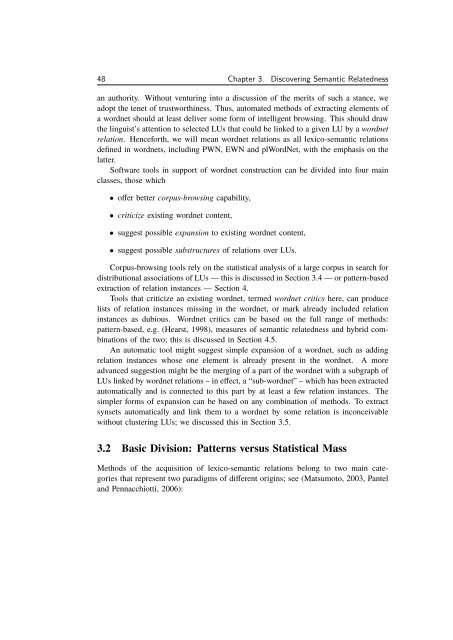A Wordnet from the Ground Up
A Wordnet from the Ground Up - School of Information Technology ...
A Wordnet from the Ground Up - School of Information Technology ...
You also want an ePaper? Increase the reach of your titles
YUMPU automatically turns print PDFs into web optimized ePapers that Google loves.
48 Chapter 3. Discovering Semantic Relatednessan authority. Without venturing into a discussion of <strong>the</strong> merits of such a stance, weadopt <strong>the</strong> tenet of trustworthiness. Thus, automated methods of extracting elements ofa wordnet should at least deliver some form of intelligent browsing. This should draw<strong>the</strong> linguist’s attention to selected LUs that could be linked to a given LU by a wordnetrelation. Henceforth, we will mean wordnet relations as all lexico-semantic relationsdefined in wordnets, including PWN, EWN and plWordNet, with <strong>the</strong> emphasis on <strong>the</strong>latter.Software tools in support of wordnet construction can be divided into four mainclasses, those which• offer better corpus-browsing capability,• criticize existing wordnet content,• suggest possible expansion to existing wordnet content,• suggest possible substructures of relations over LUs.Corpus-browsing tools rely on <strong>the</strong> statistical analysis of a large corpus in search fordistributional associations of LUs — this is discussed in Section 3.4 — or pattern-basedextraction of relation instances — Section 4.Tools that criticize an existing wordnet, termed wordnet critics here, can producelists of relation instances missing in <strong>the</strong> wordnet, or mark already included relationinstances as dubious. <strong>Wordnet</strong> critics can be based on <strong>the</strong> full range of methods:pattern-based, e.g. (Hearst, 1998), measures of semantic relatedness and hybrid combinationsof <strong>the</strong> two; this is discussed in Section 4.5.An automatic tool might suggest simple expansion of a wordnet, such as addingrelation instances whose one element is already present in <strong>the</strong> wordnet. A moreadvanced suggestion might be <strong>the</strong> merging of a part of <strong>the</strong> wordnet with a subgraph ofLUs linked by wordnet relations – in effect, a “sub-wordnet” – which has been extractedautomatically and is connected to this part by at least a few relation instances. Thesimpler forms of expansion can be based on any combination of methods. To extractsynsets automatically and link <strong>the</strong>m to a wordnet by some relation is inconceivablewithout clustering LUs; we discussed this in Section 3.5.3.2 Basic Division: Patterns versus Statistical MassMethods of <strong>the</strong> acquisition of lexico-semantic relations belong to two main categoriesthat represent two paradigms of different origins; see (Matsumoto, 2003, Panteland Pennacchiotti, 2006):



